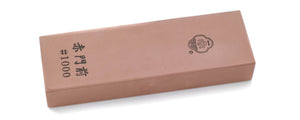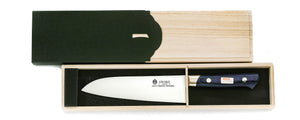Introduction to Japanese Kitchen Knives Part 4: Handles and Finishes
Welcome to Part 4 of our "How to Choose a Japanese Knife" Series.
This part will cover how to choose the right knife handle for you, and how you want the knife to look. If you want to read the entire journey, go back to Part 1 here.
At this stage we have looked at whether you should get a forged or stamped knife, as well as the blade length, layering type, forge quality, region, and steel you are looking for.
Let's help you finish off your knife recipe! We're almost there!
How a Knife Feels and Looks
The knife is almost complete! It's been handed off for the finishing stages, which involve applying the finish to the blade and attaching the handle. While these may look like just cosmestic stages, they are as important as every other step. Besides, a knife that is fun to use is a knife you'll use more often!
Let's start with the handle first. Remember, like previous parts we are assuming the knife will be a chef's knife.
A knife needs to be comfortable to hold, and the handle (plus your grip) determines almost all of that. Handles can be broken down into two major types - Western-style and Japanese-style. Both handle types come in many different materials, with benefits and demerits.
Knife Handles and Balance
Western-style handles are what most people are used to and may already have in their homes. Rivets attach wood firmly to the knife's core and heavy steel bolster, balacing the knife towards the handle. This handle is durable, but hard to replace.
Japanese-style handles like the ones above are burned onto a thinner core, staying attached with pressure. Sealant is then applied to prevent water getting in. These lightweight handles need more care, but can be replaced at home. Their bolsters are mostly made from buffalo horn, moving the knife's balance forward. A Japanese-style handle may also be lacquered, increasing durability. It may also have no bolster!
There are other handle types too. Handlesmiths the world over make unique shapes and use varied materials. Even other styles exist - remember the Chinese-style knives we talked about in Part 1? Their handles are incredibly short and often circular in nature, balancing the knife to the blade. But in the world of professional Japanese knives, you'll normally see Japanese-style and Western-style.
The handle can sometimes also impact the knife's name. As we covered in Part 1, a Japanese chef's knife is also called a gyuto. If we put a Japanese-style handle on it, it is now called a Wa-Gyuto. In this instance, wa (和) means Japanese-style. This can apply to some other knives too, like wa-santoku and wa-petty knives. And as we saw with yo-bocho in Part 1, it goes the other way too! For example, Yo-Deba (Western Deba) also exist. In this instance, yo (洋) means Western-style.
A kitchen knife's finishing touches
Now it is time to choose how the knife is polished and finished. This involves abrasives like sanding belts, whetstones, polishing powders, and grinding wheels. These abrasives refine the blade shape and edge. Polishing and finishing are different things, but one can impact the other. Some of these are made during the production cycle, some are done right at the end - and can even be done at home!
The amount of time spent polishing and sharpening a blade directly reflects in its cost. Much of a knife's cost is expertise, time, and craftsmanship. A blade with more polishing will both feel and perform better than one with less polishing, but will cost more as it takes longer to do. Some polishing may be done to the spine and chin of the blade too. While that does not impact the finish as much, it does impact the performance as it makes the knife more comfortable to hold.
Finishes are often created during the production of the knife steel itself, and can't easily be added later, if at all. It's better to decide what you want on a knife before you buy it, instead of trying to change it after the fact. However, you can create some finishes via polishing! The most well known of this is the mirror finish, which you can do at home with effort and patience. We have a guide to show you how!
Some finishes cost a lot more than others. For example, if a blade is polished to a mirror finish, it will cost more than something with a simple machined finish. Polishing a chef's knife to a mirror finish can take at least 30 hours of manual work, if not longer!
Let's see some of the more common finishes in kitchen knives.
Kasumi - Polished "Haze" Finish
The kasumi, or mist/haze finish, is the classic style for Japanese kitchen knives. Known for its refined look and craftsmanship, it displays a soft hazy pattern along the boundary between hard steel and soft iron, and remains the most common finish on traditional Japanese knives.
Tsuchime - Hammered Finish
A pattern is hammered into the blade. This finish is sometimes seen complementing other finishes. For example, a knife can have both a tsuchime finish and damascus finish applied like below on the boundary between the nan-tetsu and core steel. It's up to what the knifemaker wants to express!
Kurouchi - Black "Powder-type" Finish
A Japanese traditional finish made by leaving black forge residue on the blade, which adds rust resistance as well as a rustic charm. This finish ages and changes over time as the forge residue wears off, so it creates interesting and unique imperfections in the knife's color as it wears and peels away. This is one of the more popular finishing styles, as it adds a striking contrast without too much cost.
Nashiji - Grey "Pear-type" Finish
A traditional Japanese finish that is named after the asian pear, also called a nashi pear. Grey in color with a slightly rough, bumpy texture, it is said to feel like a nashi pear if you rub over it with your hands. It's created by removing what you would see on a kurouchi finish without cleaning or polishing the surface underneath which leaves interesting patterns and indents. Like the kurouchi finish, this pattern will change overtime.
Kyomen - Mirror Finish
An extremely time consuming polish prized amongst professional chefs, requiring many stones, papers, liquids and pastes. It takes a very long time to make this finish, but improves performance - plus you can see your own reflection! This finish requires extreme care, as scratches become visible quickly.
Damascus - Patterned Finish
By far the most commonly asked about finish is the Damascus steel finish. Damascus steel is already forge welded to the blade, but polishing steps like acid or sand blasting bring out the patterns. Sometimes chemical solutions are used to enhance this effect. Many different Damascus patterns exist, as well as methods to bring the finish out. We have an article on this here!
Suminagashi - "Ink flowing-type" Damascus Finish
A type of Damascus unique to Sakai-made knives. The pattern penetrates deep into the blade, so sharpening will not remove it. This finish is a sign of true quality, as only few can make it. It is also a Damascus finish often seen on carbon steel knives.
The Final Knife Recipe
You should now be able to determine all the aspects of what you want your knife to be.
Here's our completed knife recipe!
I want a double-edge forged, multi-layered Japanese chef's knife made in Sakai, Japan, that has a blade length of 240mm, and is made of VG-10 stainless steel, using a Japanese-style handle that is lacquered.
That looks a little long and daunting. But, if we apply the words taught in this guide you can make the recipe significantly shorter. Take a look at the below and compare the differences.
I want a Sakai-made 240mm wa-gyuto, using forged VG-10 with a lacquered handle.
Both the recipes above are the same, just written differently! If you came to our store with that recipe, we would have just the knife for you! That would be our Kirameki VG-10 Suzuchirashi Wa-Gyuto knife, a knife we mentioned back in Part 1!
A recipe can be as long or short as you like. Let's try it again!
I want a 210mm zenkou Japanese chef's knife, made of stainless steel using a Western-style handle.
This would be our SWORD-FV10 Gyuto! Small recipe changes can change the recommended knife completely. For example, just changing the recipe to a Japanese-style handle request would change the knife to our VG-10 Wa-Gyuto, or VG-1 Wa-Gyuto as the type of stainless steel was dropped from the recipe. It even opens up our Kirameki VG-1 Steel Handle Gyuto to the mix! The more specific your recipe is, the more choices are eliminated for you to get to your decision faster. It's up to you how specific or flexible you want to be!
With that, our guide is complete! It's easy to decide on what you want your knife to be made up of once you know how! But deciding what actual knife type you want? That's a very different question, with a very different guide to read! Go check that guide out if you wish, or contact us with your knife recipe and we can help you find our what's best.
If we don't have that precise knife available, we take custom orders as well via our contact form. Use your knife recipe to make your dream knife.
If you want more tutorials like this, be sure to subscribe to our Japanese and Global YouTube channels! Or, sign up to our newsletter at the bottom of the page for notifications when new educational materials go live.
From all of us at Sakai Ichimonji Mitsuhide, Happy Cooking!































